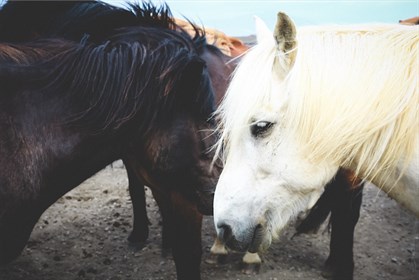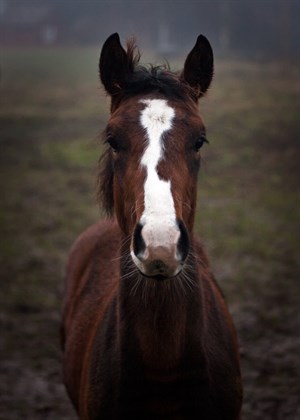
This article has appeared previously with Equestrian Life. To see what's in our latest digital issue, click here.
Strangles is more common when there are many living horses together.
Question: Hi Maxine. I’ve been hearing a lot about strangles recently. Can you tell me more about this disease, how contagious it is, and what I can do to prevent my horse getting it? -- Emily, SA.
BY MAXINE BRAIN
ANSWER: STRANGLES IS a highly contagious respiratory disease in horses that is caused by the bacteria, Streptococcus equi, subspecies equi (S equi). Strangles is seen more commonly in younger horses, generally less than five years old, particularly in environments where there are a lot of horses mingling together, such as weaning time, horse sales, or at breaking-in establishments.
Young horses typically have lower levels of immunity to the strangles bacterium than older horses, and when new horses are mixed together, the stress levels increase in these young horses, further decreasing the strength of their immune system and making them more susceptible to disease. The more horses are allowed to intermingle with other horses, the more risk there is that one will introduce a disease.
Affected horses usually present with a fever (temperature above 39C), a snotty nose (like custard) and swollen lymph nodes under the jaw. These lymph nodes will often abscess and burst, discharging thick pus from the wounds under the jaw. The most common sites of lymph node abscessation are the two lymph nodes under the back part of the jaw, referred to as submandibular lymph nodes. Other lymph nodes around the head and neck can be involved, and when enlarged, these can block the airways, giving the disease its common name “strangles”. Occasionally, the bacteria spread through the body and localise in other lymph nodes around the body, forming abscesses in areas like the chest and abdomen, known colloquially as “bastard strangles”. Clinical signs are generally seen 3-14 days following exposure to the disease, and generally the horse will continue to show signs of the disease for an average of 23 days.
While strangles has a low risk of mortality, if the disease is introduced into a group of horses that are susceptible to the disease (ie: not vaccinated and with no immunity to strangles), the number that will catch it and show the clinical signs is very high, up to 100%.
Horses become infected either by inhaling or ingesting the S equi bacteria that they pick up from other infected horses, or from handlers, contaminated yards, water troughs, and equipment such as leads, head collars, buckets etc. The organism usually only survives in the environment for short periods, however, the bacteria can survive longer in moist discharges, making both nasal discharges and pus from abscesses highly infectious to other horses.
Treatment for strangles is primarily aimed at general nursing care unless complications develop or a potentially large population of horses is involved and treatment is intensified to reduce the size of an outbreak. In simple non-complicated cases of strangles, lymph node abscesses should be lanced (or if they burst on their own) and allowed to drain. The abscesses should be flushed and cleaned with a weak iodine solution (2%). Unless the horse appears unwell, depressed, is not eating or has a high temperature, it is not necessary to give antibiotics. The majority of horses will recover uneventfully once the abscesses have been opened. There is some belief that the use of antibiotics is warranted in the face of an outbreak, when a horse spikes a temperature but has not yet developed enlarged nodes. In these cases it is thought that the bacteria can be killed before the abscess begins to form. Once an abscess begins to form, however, giving penicillin slows down the development of the abscess, and in some cases prevents it progressing to the stage of being able to be lanced or burst on its own. Once the antibiotics are stopped, the abscess will begin to redevelop because the bacteria inside the abscess have not been killed, thus prolonging the course of the disease.
There are a number of important complications which can occur following infection with strangles. Fortunately these are uncommon but should be listed for completeness of this answer. As mentioned, horses can develop internal abscesses (“bastard strangles”) which can rupture, causing the horse to become very sick and in some cases die. Horses with internal abscesses become ill and depressed, resulting in the need for further diagnostic tests such as blood tests and ultrasound examinations. Lymph nodes around the throat and near the trachea can enlarged to the point where they totally obstruct the air flow to a horse’s lung, which if not able to be treated can result in the horse suffocating. Abscesses around the throat can rupture into the guttural pouches, (which are like eustachian tubes in people), and long-term persistent infections can be established requiring surgery or some form of drainage to eliminate persistent snotty noses from occurring.
Purpura haemorrhagica is a vasculitis (inflammation of the blood vessels) which can occasionally develop a couple of weeks after the horse has had strangles and is displayed clinically as swollen (oedematous) limbs, small haemorrhages in the mucous membranes, progressing to large areas of skin sloughing and oozing serum. It is believed to be an immune mediated condition. In very simple terms, it is believed that the horse’s system begins to attack its own blood vessels because a cascade of events are set in motion whereby antigen from the S equi is deposited on the walls of the vessels which triggers the horse’s immune system into believing the vessels are foreign and need to be eliminated. It can occasionally occur after vaccination with the strangles vaccine, but this is not very common. Treatment usually involves high doses of corticosteroids, but is a condition that really needs to be diagnosed and treated by your veterinarian.
Prevention
As mentioned in a previous article, the best way to reduce the risks of strangles is to vaccinate your horses with the strangles vaccination that is readily available in Australia. The vaccine needs to be given three times, at two-week intervals, to have the best level of coverage. Yearly boosters are required to maintain an adequate level of immunity, however, in high-risk situations a six-monthly booster is recommended. The natural immunity a horse gets following an infection is much stronger than that following a vaccine and can protect the horse from strangles for up to five years.
Young horses are more likely to contract strangles.
© Christian Holme´r
Other ways to reduce the risk of introducing strangles onto your property is to establish good husbandry protocols, such as isolating any new horses on the property for two to three weeks before allowing them into the general horse population.
If strangles does become an issue on the farm then the ideal way to manage the outbreak and reduce the spread of the disease is to divide horses into three groups.
1) Isolate and quarantine any horses that are showing clinical signs of strangles.
2) Quarantine all horses that have been exposed to affected horses that are showing signs of strangles, even if they are not showing any symptoms themselves.
3) Isolate all other horses that have not been exposed to diseased horses.
All horses should have their temperatures taken daily (or twice daily if possible) and monitored for any signs of strangles. A horse with a temperature but no other clinical signs may need to be isolated to ascertain if it does have strangles, in case it has a temperature for an unrelated reason. Any infected horses identified should be immediately transferred into the affected group.
If possible the three groups of horses should be isolated to their own area of the property to minimise the risk of contact between infected and non-infected horses. Ideally there should be no sharing of farm personnel or equipment. The risk of contamination can be reduced with the use of footbaths and hand-washing stations in areas exiting and entering contaminated paddocks. If it is not possible to separate staff or equipment between areas then all equipment should be thoroughly disinfected before use and staff should, if possible, change clothes and exercise a high level of hygiene.
It is important to note that horses remain infectious for many weeks after they stop showing signs of strangles. Hence it is important to keep these horses in isolation or quarantined for about four weeks after resolution of clinical signs to minimise the risk of spreading the disease further. It has been shown that some horses can be carriers without showing any symptoms of the disease itself. This can result in horses getting strangles even where there have been no new horses introduced to the farm. If this does occur it may be necessary to screen horses to try and identify the carrier, however, this is something which should be discussed with your veterinarian should you have an outbreak of strangles which you cannot explain by direct exposure to an infected horse.
READ THE LATEST NEWS ARTICLES HERE
https://www.equestrianlife.com.au/articles/All-the-angles-on-strangles


